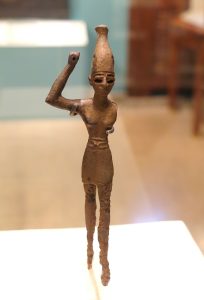Texts from the Canaanite kingdom of Ugarit name Mount Zaphon as the site of Baal’s palace, but the capital of the kingdom of Yamḥad, Halab (modern Aleppo), was the City of Hadad, so called after the proper name of the storm-god. (Baʿal was a title that means “lord.”) The god’s sanctuary there, which lies beneath a massive citadel in Aleppo’s old quarter, dates to the Early Bronze Age, around 2500 BC, and it was in use until about the 9th century BC.

The importance of the storm-god of Aleppo is highlighted by evidence of his cult across Mesopotamia and the Levant, from Nuzi, east of the Tigris River, to Hattuša, capital of the Hittite empire, in what is now north-central Turkey. By the old Babylonian period, roughly 1900-1600 BC, Hadad was the preeminent god in Mesopotamia. Emissaries from Elam (northwestern Iran) traveled to Aleppo to present the god with a bow as a gift.
Yamḥad enjoyed the benefits of the storm-god’s presence in its midst. The king was called “beloved of Hadad” and the kingdom was the Land of Hadad. The god bestowed kingship and assigned territory to kings, even to those outside the borders of Yamḥad. Before the Amorites swept into southern Mesopotamia and took control from the native Sumerians in the early 2nd millennium BC, that power was restricted to Enlil. (After the rise of Babylon, various deities including Hadad Marduk, Dagan, and the moon-god Sîn, claimed king-making authority at different times and places.)
If you’re a reader of the Bible, you recognize that this is another bit of propaganda from the spirit realm. Scripture tells us “there is no [governing] authority except from God, and those that exist have been instituted by God” (Romans 13:1, ESV).
It was believed that the sacred weapons forged for Baal by the craftsman god, Kothar-wa-Khasis (“Skillful-and-Wise,” or “Deft-and-Clever”), to defeat the sea-god Yam were kept at the temple of Hadad in Aleppo. Letters found at Mari, a Bronze Age Amorite kingdom centered on the Euphrates near the modern border between Syria and Iraq, confirm that the weapons, clubs named Yagrush (Chaser) and Aymur (Driver), were transported from Aleppo to the city of Terqa for Zimrī-Līm, the king of Mari during the time of Hammurabi (c. 1775 BC), and placed in the temple of Mari’s chief god, Dagan.
This is fascinating on a couple of levels. First, the clubs were actual physical objects that could be brought out and displayed during ceremonies. Second, the weapons apparently had a ritual function. Whether the clubs were returned to Aleppo, we don’t know, but it raises a disturbing thought: This is sheer speculation, but is it possible that these weapons, whatever they were, still exist, are in Aleppo today, and are somehow spiritually linked to the savage violence of the Syrian civil war?
Roughly 80 miles west of Aleppo, Mount Zaphon, the home of Baal’s palace, was known to the Greeks as Mount Kasios. The Greek storm-god Zeus was naturally identified with Baal-Hadad, and the aspect of Zeus who reigned there was known as Zeus Kasios (Jupiter Casius to the Romans).
We mentioned earlier that Mount Zaphon/Kasios was the site of the epic battle between Zeus and the chaos monster, Typhon, which is a clear parallel with Baal’s victory over Yam and his minion, the sea dragon Lotan–which is the Canaanite form of the name Leviathan.
The victory of a god over the chaos monster representing the sea or, as scholar Robert D. Miller termed it, the “storm-god-slays-dragon myth,” is a theme that stretches back to Sumer. The Zeus-Typhon and and Baal-Yam conflicts were preceded by the Hittite myth of Tarhunt and the dragon Illuyanka, the Indian myth of the god Indra’s defeat of the dragon Vrtra (with a thunderbolt, naturally), and before that, the account of Marduk and Tiamat in the Babylonian creation epic, the Enuma Elish.
In the god lists found at Ugarit, which serve as a lexicon between Ugaritic and Akkadian, Tiamat is equated with Baal’s nemesis, Yam. After his victory over Tiamat, Marduk, like Baal, was declared king of the gods and had a palace built in his honor.
Some scholars have observed that because no copy of the Enuma Elish predates the tablets containing the Baal Cycle found at Ugarit, and it probably originated no more than two hundred years before the Baal Cycle, the storm-god-slays-dragon myth may have traveled to Babylon from the region around Mount Zaphon and not, as is generally assumed, the other way around. This makes a lot of sense. It’s far more likely that people near the Mediterranean would envision the sea as a monstrous opponent of the gods than the inhabitants of arid central Mesopotamia.
As we mentioned earlier, the Sumerian storm-god Iškur may well have been a Semitic import. The Amorites were in contact with southern Mesopotamia from an early age. As with the belief that the storm-god was king of the gods, the account of his triumph over chaos may have traveled west to east with Amorite caravans. Of course, these tales were a PSYOP to lay claim to the victory that Yahweh had won over Leviathan and chaos.
There is another connection linking all these stories: We previously mentioned a letter to Zimrī-Līm, the king of Mari, confirming receipt of the weapons of Hadad at the temple of Dagan in Terqa. The king also received a message purportedly from the god himself through one of his prophets:
Thus says Adad [Hadad/Baal], I brought you back to the throne of your father, I brought you back. The weapons with which I fought Tiamat I gave to you. With the oil of my bitter victory I anointed you, and no one before you could stand.
A Prophetic Letter of Adad to Zimrī-Līm (A.1968)
The word translated “Tiamat”, têmtum (a variant form of Tiamat), is a cognate of the Hebrew word tehom, which appears in the very second verse of the Bible:
In the beginning, God created the heavens and the earth. The earth was without form and void, and darkness was over the face of the deep (tehom). And the Spirit of God was hovering over the face of the waters.
Genesis 1:1-2, ESV
Linking the Sumerian chaos goddess, Tiamat, and “the deep” of Genesis 1:2 puts that verse in a new light. Why did the Spirit of God hover over the waters? Is it possible Yahweh defeated a divine rebel before creating Adam and Eve? And having cast Tehom/Tiamat into the abyss, did His Spirit remain to guarantee the monster would stay there?
Thus, the creation of the world as recorded in Genesis is linked to the Enuma Elish, the Baal Cycle, and the storm-god-slays-dragon myths of ancient Anatolia and Greece, and probably the nightly contest between Set and Apophis, the Indian myth referenced above, the battles between Thor and Jörmungandr, and others.
Not surprisingly, secular scholars generally believe the Genesis account was inspired by the Babylonian myth instead of the other way around. But the oldest written account isn’t necessarily the one that’s true.
Why is all of this about the storm-god relevant? Because Isaiah 14:13 identifies Mount Zaphon—yarkete tsaphon in the Bible (usually translated “heights of the north,” “uttermost north,” or “sides of the north”)—as the “mount of assembly” of the rebel from Eden, and the rally point for the end-times army led by Gog of Magog. And Jesus identified the storm-god as Satan.[1]
In other words, Satan is Baal—and by extension, Zeus, Jupiter, Thor, and every other pantheon’s incarnation of the storm-god.
Think about that. Two thousand years ago, Jesus called this creature the Father of Lies. Today, he’s a wisecracking superhero some of the biggest movies in history.[2]
[1] Matthew 12:23-24 and Revelation 2:13. Jesus linked Beelzebul (“Baal the Prince”) to Satan, and “Satan’s seat” in Pergamum was the Great Altar of Zeus, the Greek version of the storm-god.
[2] Avengers Endgame earned $1.2 billion in its opening weekend, a record.


Keep up the great work of breaking down your research topics in detail. It is very informative and will inspire many to look into the topics further and hopefully allow the Holy Spirit to guide them to the truth of Christ Jesus.
(Bronze figurine of Baal found at Megiddo dated to Late Bronze Age (c. 1550–1200 BC) ) The Bronze figure of Baal has small breasts. So, it looks to me to be a hermaphrodite. Much of satan’s minions are hermaphrodites. They have both breasts & male equipment. But they cannot re-produce.
That may just be due to an unskilled metalsmith. I haven’t run across anything in the Ugaritic texts that depict Baal as anything but male.
OK – so “Satan is Baal—and by extension, Zeus, Jupiter, Thor, and every other pantheon’s incarnation of the storm-god.” Remind me again – or confirm – then Saturn is NOT Satan. Who is Saturn and what is the proof that is he not Satan? Where does Saturn fit into the big picture? Thanks.
In The Second Coming of Saturn, I make the case that Saturn is Shemihazah, chief of the Watchers. You can read most of the book online for free at my website.
Thank you so much for sharing your insights. I’m looking forward for next posts. I’m an art teacher, your explanations are so precious!
About the pantheons, there’s always a guy on the top. The Zeitgeist Movement acknowledges this fact, but totally misses the point and is destroying the faith of so many people.
Let the Lord bless you and your wife.
Dang it. I need a reference chart. Is there one? How do you keep track of all these gods and rebels over the ancient timeline? Seriously, how do you keep track? Is it just because you are immersed in it for all your books and study? Or is there a reference chart somewhere?
S